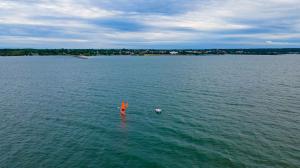Collecting data to improve fish counts, monitor environmental health, and help to protect native fish species.
— Matt Womble, Saildrone director of ocean data programs
ASHLAND, WISCONSIN, USA, August 10, 2022 /EINPresswire.com/ — Saildrone has launched two Saildrone Explorer uncrewed surface vehicles (USVs) on a large-scale, multi-partner mission in Lake Superior supporting the sustainable management of the $7 billion per year Great Lakes fishery. Led by the US Geological Survey (USGS), the 25-day mission brings together state, federal, tribal, Canadian provincial, private, and non-profit partners using advanced fishery research approaches to enhance fishery assessment methods.
The Great Lakes are one of the most ecologically diverse ecosystems on Earth, home to nearly 139 native species of fish. Commercial, recreational, and tribal fisheries support more than 75,000 jobs. Estimation of prey fish abundances in the Great Lakes is a central part of the USGS Great Lakes Science Center (GLSC)’s annual commitments to fisheries managers throughout the Great Lakes.
The 23-foot Saildrone Explorer carries sensors to measure fish distribution and density data around the clock. The saildrones, which have a zero operational carbon footprint and operate virtually silently, will enable USGS scientists to better understand the effects of large vessel engine noise on fish sampling and catchability. They will also provide supplemental data on the abundance of rainbow smelt, an invasive prey fish species that has become thoroughly integrated into Great Lakes food webs.
“The USGS strives to continuously enhance the quality of our science by integrating cutting-edge technologies into our research,” said Peter Esselman, a USGS biologist and the project lead. “The data collected during this Lake Superior mission will help Great Lakes fishery managers make the most informed decisions possible to sustain the fishery.”
The Saildrone Explorer is a proven platform for acoustic fisheries surveys, having performed numerous fish stock assessments in the Arctic, along the US West Coast, and the North Sea. Powered by wind for propulsion and solar energy to run onboard instruments, Saildrone USVs have demonstrated their capabilities around the world, from lakes to the treacherous Southern Ocean to the eye of Atlantic hurricanes.
“Saildrone uncrewed surface vehicles (USVs) have already sailed 800,000 nautical miles and spent 18,000 days at sea—and counting—collecting data to serve a wide range of research objectives, from seafloor mapping and maritime security to climate science and sustainable fisheries management. Sustainable fisheries management is imperative not only for the long-term health of the fisheries but for the Great Lakes ecosystem as a whole,” said Matt Womble, Saildrone director of ocean data programs.
This is the second year of a multi-year mission in the Great Lakes. In Summer 2021, two Saildrone USVs were deployed from Holland, MI. The vehicles sailed up Lake Michigan to the Straits of Mackinac and then down Lake Huron before being recovered in Port Huron.
Susan Ryan
Saildrone, Inc.
+1 314-914-5008
email us here
Visit us on social media:
Facebook
Twitter
LinkedIn
Other
![]()




















